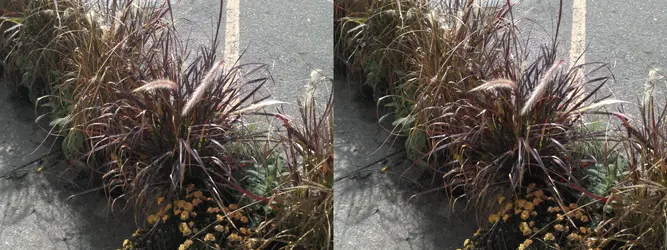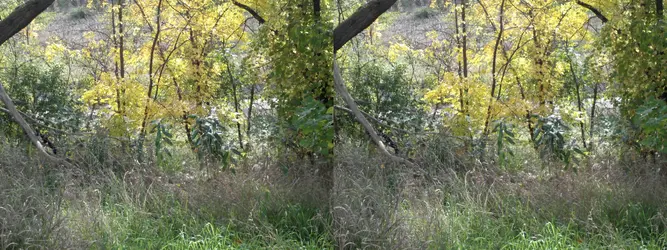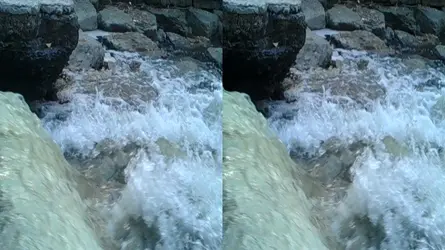VidThreeNorth
No longer a newbie, moving up!
- Joined
- Oct 21, 2016
- Messages
- 1,413
- Reaction score
- 353
- Can others edit my Photos
- Photos NOT OK to edit
LG 3D Phones: LG P920, P925, etc.
[P925g, P720, SU870]
Canon's recently introduced their RF5.2mm f/2.8L Dual Fisheye 3D lens, and I realized that I had not released anything 3D in a long while. I make occasional use of 3D stills for personal documentation, but lately my release-able projects have been in 2D. So I thought about what I could do fairly quickly to support 3D, and for the near term, I thought that clearly it would have to be "stills". After a few ideas, I settled on created some posts about my "LG-P925g" Optimus 3D.
I think I bought mine early in 2012. It is a localized version of the "Optimus 3D P920 sold by Rogers Wireless. As far as I can remember, mine came with Android version 2.3.5, Kernel version 2.6.35.7. This is what I have currently loaded, and I do not recall it being upgraded. That does not mean that Rogers did not have an upgrade available, but I will try to get back to that issue later. Researching the P920/P925 models, I can say that they appear to be the same, and firmware versions apparently ranged from Android 2.2 up to 4.0. If I can upgrade to a version of 4.0, that might fix problems that I have encountered.
The Supported 3D Formats:
Around 2011 when LG decided to go 3D, file standards were in flux, so it was reasonable that LG created a new one for still pictures. Their "JPS" (JPEG Stereo?) format was two side by side normal (not anamorphic) pictures 2048 x 1536 each, forming a single JPEG 4096 x 1536 image. The P925g would display this on its 800 x 480 screen in a proper stereoscopic 3D image without special glasses.
For Video, it supported up to a standard 1080p 2D file or 720p stereoscopic 3D MP4 file. Depending on the model (apparently there were two), the 2D file was either 30p or 24p. The 3D file was the same 30p on both. But no matter which, and no matter how well the imaging quality was, for 3D, they started with a ~2.3 cm baseline, which I felt was not very useful. So although I did try stills and video briefly at the time I bought it, I did not really used it beyond my initial tests. For me, the value in the device was its very good 3D viewing capability.
Not long after, I bought my first Gadmei 8" 3D tablet which had a better display, and so, without a good camera system and a "lesser" screen the LG ended up "sitting". The only real problem with such a result is that I never checked for firmware updates later. In general, LG did provide upgrades for it, but I would need to get mine from Rogers, for which I currently have no account. Such and upgrade could have resulted in major benefits.
The Stills:
It so happens that the file sizes of the stills seem to average 2mb, which happens to be the upload size limit for this forum. Unfortunately, so far, the pictures I like have been a bit too large. I thought about shrinking the files (width and height) which is what I normally do when I upload samples, but they were so close, that I decided to upload the files in the same dimensions, and re-compress them at lower quality levels.
What Can You Do With Them?
If you only have a normal 2D viewing device, then just look at them as-is. You will see a pair of images side by side. This is not very exciting, but if you are curious about what I uploaded, then you will have that much of an answer.
If you have a 3D viewing device or app that directly handles "JPS" files, you should be able to rename the uploaded files from "jpg" to "JPS" and view them directly as 3D.
If you have a 3D viewing device that can display 3D, but not from a "JPS" file format, then if you want to, you can do whatever you need to do to convert it to a supported file. A fairly common "old" format is simple side - by - side, but horizontally compressed anamorphic. This is a fairly easy conversion in most still picture editors.
The third option might be a little more difficult. You can convert the two side by side images into an "MPO" format. Unfortunately, I cannot tell you what programs can handle this conversion, but "MPO" is the proper standard format for 3D stills. I believe that Panasonic cameras now output MPO format files if you use their 3D lens on it.
Lastly, and most likely these days, if you have a Google Glass style adapter and a phone with a screen around 5" - 6", then you can display the file on your phone using an ordinary pictures viewing app and the "Google Glass" adapter will allow you to see it in 3D.
Can 3D be viewed easily on 2D devices?
Actually, I would say "sort of yes". If you have an app that will display 3D using "wiggle 3D", this can be done. Whether you find it acceptable is not something I can tell you. "Wiggle 3d" alternately shows the left and then the right images in rapid alternation. This might be dangerous for people with sensitivity to flashing lights (epileptics). And some people simply do not like to view this. I have seen it and, it works for me, but I do not like it. I prefer to use real 3D viewing devices instead. I do not even know what programs are capable of "wiggle 3D".
I have four samples to upload right now. I have more pictures that I am looking through, and I have tried to make some new videos. I will discuss this later. For now, I have listed the original file names and their corresponding original sizes, followed by the names of the "recompressed" files that I am uploading.
One word about 3D compositions: If you do a good job of composing in 2D, you might not find a 3D version adds anything. The result is a disappointing image. On the other hand, the samples I am uploading to day, I would call "poor" 2D compositions, but if you see them in 3D, you will find them much better. It is possible to have compositions that are good, both in 2D and 3D, but having done this for years, I would say that I do not generally like such "universal compositions" because they tend to be "obvious". I like the compositions, like the pictures I am uploading, which are not so obviously "good" when viewed in 2D. The element of surprise, is something that I find attractive in these compositions. This is, of course, a personal taste issue, and someday I might change my mind about it, but that is my current taste/opinion.
"IMG039.JPS" [Not Uploaded]
Size: 2,236,699 bytes
"IMG039-C13.jpg"
"IMG042.JPS" [Not Uploaded]
Size: 2,067,003 bytes
"IMG042-C11.jpg"
"IMG045.JPS" [Not Uploaded]
Size: 2,473,403 bytes
"IMG045-C14.jpg"
"IMG066.JPS" [Not Uploaded]
Size: 2,022,314 bytes
"IMG066-C10.jpg"
[P925g, P720, SU870]
Canon's recently introduced their RF5.2mm f/2.8L Dual Fisheye 3D lens, and I realized that I had not released anything 3D in a long while. I make occasional use of 3D stills for personal documentation, but lately my release-able projects have been in 2D. So I thought about what I could do fairly quickly to support 3D, and for the near term, I thought that clearly it would have to be "stills". After a few ideas, I settled on created some posts about my "LG-P925g" Optimus 3D.
I think I bought mine early in 2012. It is a localized version of the "Optimus 3D P920 sold by Rogers Wireless. As far as I can remember, mine came with Android version 2.3.5, Kernel version 2.6.35.7. This is what I have currently loaded, and I do not recall it being upgraded. That does not mean that Rogers did not have an upgrade available, but I will try to get back to that issue later. Researching the P920/P925 models, I can say that they appear to be the same, and firmware versions apparently ranged from Android 2.2 up to 4.0. If I can upgrade to a version of 4.0, that might fix problems that I have encountered.
The Supported 3D Formats:
Around 2011 when LG decided to go 3D, file standards were in flux, so it was reasonable that LG created a new one for still pictures. Their "JPS" (JPEG Stereo?) format was two side by side normal (not anamorphic) pictures 2048 x 1536 each, forming a single JPEG 4096 x 1536 image. The P925g would display this on its 800 x 480 screen in a proper stereoscopic 3D image without special glasses.
For Video, it supported up to a standard 1080p 2D file or 720p stereoscopic 3D MP4 file. Depending on the model (apparently there were two), the 2D file was either 30p or 24p. The 3D file was the same 30p on both. But no matter which, and no matter how well the imaging quality was, for 3D, they started with a ~2.3 cm baseline, which I felt was not very useful. So although I did try stills and video briefly at the time I bought it, I did not really used it beyond my initial tests. For me, the value in the device was its very good 3D viewing capability.
Not long after, I bought my first Gadmei 8" 3D tablet which had a better display, and so, without a good camera system and a "lesser" screen the LG ended up "sitting". The only real problem with such a result is that I never checked for firmware updates later. In general, LG did provide upgrades for it, but I would need to get mine from Rogers, for which I currently have no account. Such and upgrade could have resulted in major benefits.
The Stills:
It so happens that the file sizes of the stills seem to average 2mb, which happens to be the upload size limit for this forum. Unfortunately, so far, the pictures I like have been a bit too large. I thought about shrinking the files (width and height) which is what I normally do when I upload samples, but they were so close, that I decided to upload the files in the same dimensions, and re-compress them at lower quality levels.
What Can You Do With Them?
If you only have a normal 2D viewing device, then just look at them as-is. You will see a pair of images side by side. This is not very exciting, but if you are curious about what I uploaded, then you will have that much of an answer.
If you have a 3D viewing device or app that directly handles "JPS" files, you should be able to rename the uploaded files from "jpg" to "JPS" and view them directly as 3D.
If you have a 3D viewing device that can display 3D, but not from a "JPS" file format, then if you want to, you can do whatever you need to do to convert it to a supported file. A fairly common "old" format is simple side - by - side, but horizontally compressed anamorphic. This is a fairly easy conversion in most still picture editors.
The third option might be a little more difficult. You can convert the two side by side images into an "MPO" format. Unfortunately, I cannot tell you what programs can handle this conversion, but "MPO" is the proper standard format for 3D stills. I believe that Panasonic cameras now output MPO format files if you use their 3D lens on it.
Lastly, and most likely these days, if you have a Google Glass style adapter and a phone with a screen around 5" - 6", then you can display the file on your phone using an ordinary pictures viewing app and the "Google Glass" adapter will allow you to see it in 3D.
Can 3D be viewed easily on 2D devices?
Actually, I would say "sort of yes". If you have an app that will display 3D using "wiggle 3D", this can be done. Whether you find it acceptable is not something I can tell you. "Wiggle 3d" alternately shows the left and then the right images in rapid alternation. This might be dangerous for people with sensitivity to flashing lights (epileptics). And some people simply do not like to view this. I have seen it and, it works for me, but I do not like it. I prefer to use real 3D viewing devices instead. I do not even know what programs are capable of "wiggle 3D".
I have four samples to upload right now. I have more pictures that I am looking through, and I have tried to make some new videos. I will discuss this later. For now, I have listed the original file names and their corresponding original sizes, followed by the names of the "recompressed" files that I am uploading.
One word about 3D compositions: If you do a good job of composing in 2D, you might not find a 3D version adds anything. The result is a disappointing image. On the other hand, the samples I am uploading to day, I would call "poor" 2D compositions, but if you see them in 3D, you will find them much better. It is possible to have compositions that are good, both in 2D and 3D, but having done this for years, I would say that I do not generally like such "universal compositions" because they tend to be "obvious". I like the compositions, like the pictures I am uploading, which are not so obviously "good" when viewed in 2D. The element of surprise, is something that I find attractive in these compositions. This is, of course, a personal taste issue, and someday I might change my mind about it, but that is my current taste/opinion.
"IMG039.JPS" [Not Uploaded]
Size: 2,236,699 bytes
"IMG039-C13.jpg"
"IMG042.JPS" [Not Uploaded]
Size: 2,067,003 bytes
"IMG042-C11.jpg"
"IMG045.JPS" [Not Uploaded]
Size: 2,473,403 bytes
"IMG045-C14.jpg"
"IMG066.JPS" [Not Uploaded]
Size: 2,022,314 bytes
"IMG066-C10.jpg"
Attachments
Last edited:

















![[No title]](/data/xfmg/thumbnail/31/31978-02cde49248ebdf1b82fba5c899e08378.jpg?1734160755)
